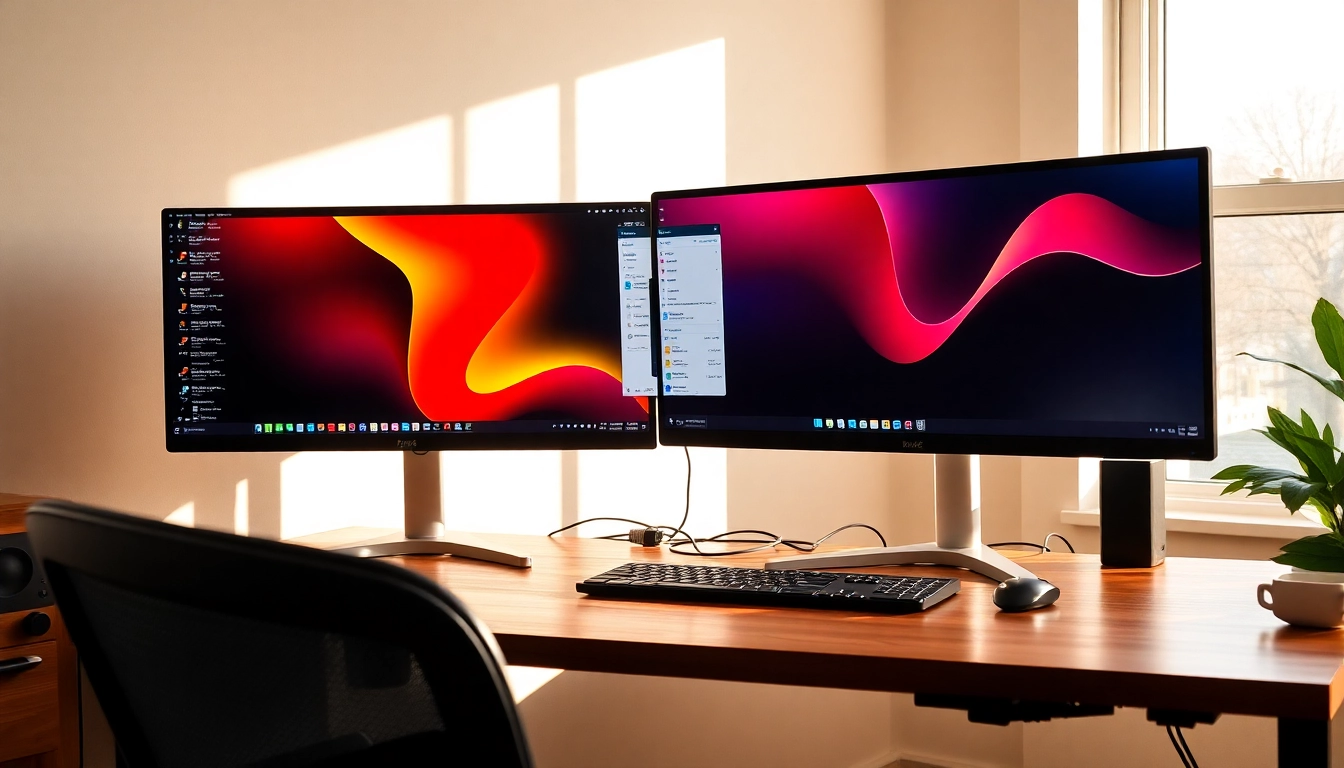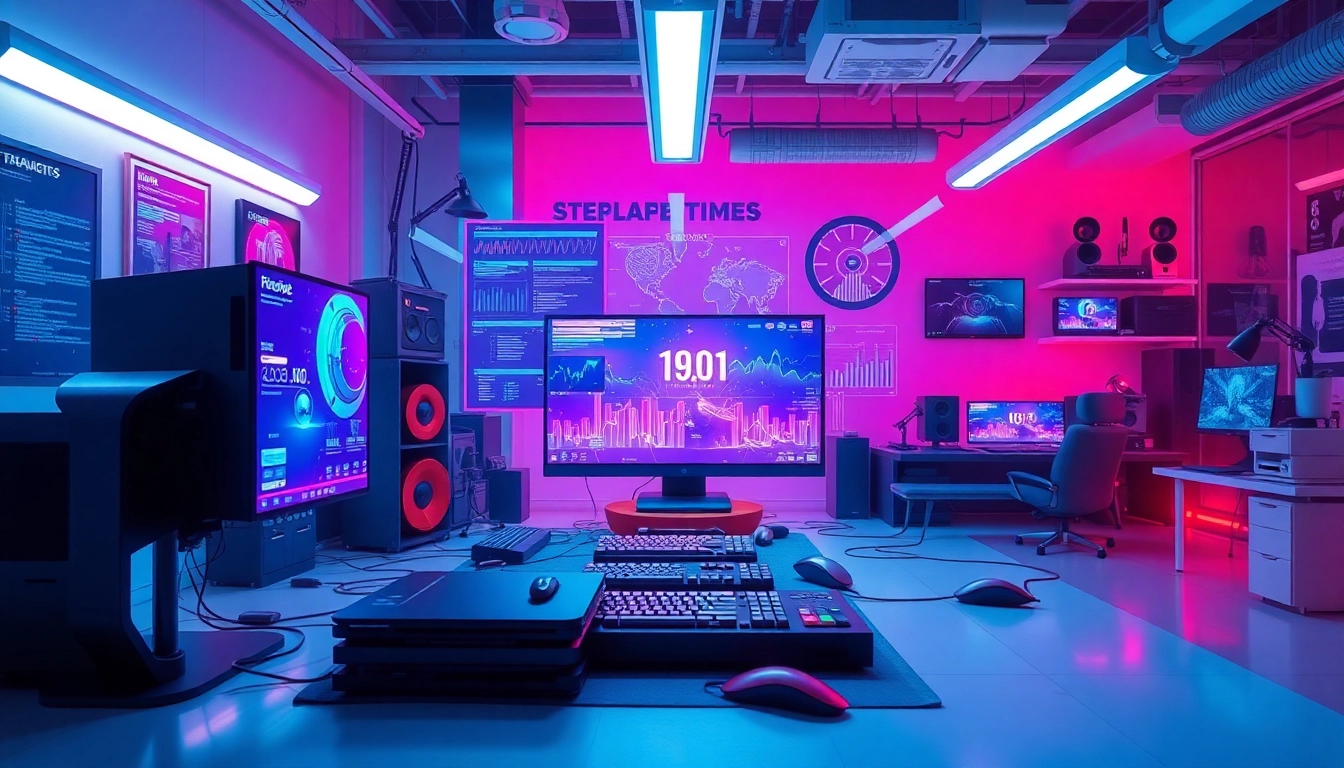Understanding Dual Monitor Install
What is Dual Monitor Setup?
A dual monitor setup involves using two screens simultaneously to enhance productivity and workspace efficiency. This configuration allows users to extend their desktop across both displays, providing more visual real estate for multitasking. Whether you’re an office worker juggling multiple applications, a gamer seeking immersive experiences, or a designer working on intricate projects, having dual monitors can be a game-changer.
Benefits of Using Dual Monitors
The benefits of a dual monitor setup are numerous:
- Increased Productivity: Studies have shown that users can complete tasks significantly faster when using two screens. With more space for open applications, there’s less need to switch between tabs or windows.
- Improved Multitasking: Dual monitors allow for simultaneous monitoring of various applications, such as having your email open on one screen while working on a document on another.
- Enhanced Workflow: Creative professionals can leverage the extra screen for design tools, timelines, or reference images, enabling a smoother creative process.
- Customizable Layouts: Users can arrange their displays in several configurations (extended mode, mirrored mode, etc.) to suit their specific needs.
Common Misconceptions About Dual Displays
Despite the advantages of dual monitor installations, there are some common misconceptions:
- Only for Tech Professionals: Many believe that dual monitors are only beneficial for tech-savvy individuals or those in specialized roles. However, any professional can benefit from increased screen space.
- Too Complicated to Set Up: While initial setups can seem daunting, once you understand your computer’s compatibility and gather the appropriate equipment, the installation process is straightforward.
Preparing for Your Dual Monitor Install
Check Computer Compatibility
Before proceeding with the installation, it’s crucial to ensure your computer can handle a dual monitor setup. Most modern computers have the necessary ports—like HDMI, DisplayPort, or Thunderbolt. To check compatibility:
- Identify the video ports available on your computer.
- Consult your computer’s documentation or manufacturer’s website for support information.
- Make sure your graphics card supports multiple displays if it’s a desktop.
Gather Necessary Equipment
To set up dual monitors, you’ll need to gather some essential equipment:
- Monitors: Ensure both monitors are similar in resolution and size for a seamless experience.
- Cables: Depending on your monitors and computer, you might need HDMI, DisplayPort, or VGA cables.
- Adapters: If your monitors and computer have different ports, adapters may be required.
- Optional Accessories: Monitor stands, a power strip, and cable management solutions can be beneficial for decluttering.
Choosing the Right Monitors
Selecting the appropriate monitors is vital for an efficient dual installation:
- Resolution: Higher resolutions (1080p or above) provide clearer visuals and more workspace.
- Screen Size: Monitors of similar size ensure that windows look uniformly sized and maintain ergonomic comfort.
- Panel Type: IPS panels offer better color accuracy and viewing angles, which are especially important for creative work.
Step-by-Step Dual Monitor Installation Process
Connecting the Monitors
Once you have all the equipment, follow these steps to connect your monitors:
- Power off your computer and unplug it from the outlet.
- Begin connecting your monitors to the appropriate ports on your computer. Use the necessary cables and adapters to ensure compatibility.
- Secure the monitors in place using stands or mounts, ensuring ergonomic positioning.
- Once everything is connected, power on the monitors followed by your computer.
Configuring Display Settings in Windows
After connecting your monitors, it’s time to configure the display settings:
- Right-click on the desktop and select Display settings.
- Select the display number you wish to configure and adjust the settings for resolution, orientation, and scaling.
- Choose whether to extend or duplicate displays by selecting the appropriate option under Multiple displays.
- Hit Apply and check if the adjustment meets your needs. You can further refine settings as required.
This step can significantly enhance your productivity. Visit Dual monitor install for more insights on configuring your setup correctly.
Troubleshooting Common Setup Issues
During the installation process, you may encounter some challenges. Here are solutions to common problems:
- No Signal: Check connections and ensure that your monitors are powered on. Confirm that the correct input source is selected on the monitor.
- Display Flickering: Ensure the cables are firmly connected and test different cables if necessary to rule out hardware issues.
- Inconsistent Display Settings: Double-check your display settings in Windows. You may need to adjust resolution settings for each monitor.
Optimizing Your Dual Monitor Experience
Arranging Your Workspace for Efficiency
Creating an efficient workspace is key for maximizing the benefits of a dual monitor setup:
- Positioning: Place your primary monitor directly in front of you, with the secondary monitor at an angle that’s comfortable.
- Desk Space: Ensure that there’s adequate desk space and that monitors are neither too far nor too close to your eyes.
- Lighting: Minimize glare by adjusting monitor angles and ensuring proper room lighting.
Adjusting Display Settings for Comfort
Comfort is vital in reducing eye strain and enhancing work performance:
- Brightness and Contrast: Adjust these settings to suit ambient lighting and reduce glare.
- Color Calibration: Regularly calibrate your monitors for accurate color representation, especially if you work in graphics or design.
- Text Size: Increase text size in your operating system settings if you find it hard to read on the screen.
Utilizing Productivity Tools
Make the most of your dual monitor setup by incorporating productivity tools and software:
- Window Management Software: Tools like DisplayFusion or AquaSnap can enhance window management across multiple displays.
- Virtual Desktops: Use this feature in Windows 10 or above for organizing tasks and applications across multiple screens.
- Task Scheduling Apps: Integrate apps that help you prioritize tasks and manage time effectively while using dual monitors.
Maintaining Your Dual Monitor Setup
Best Practices for Monitor Care
Regular maintenance of your monitors ensures longevity and optimal performance:
- Cleaning: Use microfiber cloths and specialized cleaners to avoid scratches and damage to your screens.
- Calibration: Regularly calibrate monitors to maintain color accuracy, especially if used for design work.
- Temperature Control: Avoid placing monitors in direct sunlight and ensure they have proper ventilation.
Upgrading Your Setup over Time
Your dual monitor install can evolve:
- Monitor Upgrades: As technology advances, consider upgrading to higher resolution or larger displays.
- Additional Displays: If your workflow demands even more screen real estate, consider adding a third monitor.
- Enhanced Accessories: Investing in adjustable stands, cables, or even a dedicated graphic card can improve your setup further.
Seeking Professional Help When Needed
If challenges arise that you can’t resolve:
- Technical Support: Don’t hesitate to reach out to your equipment’s customer service for assistance.
- Professional Installation Services: Consider hiring professionals if your setup’s complexity exceeds your comfort level.



